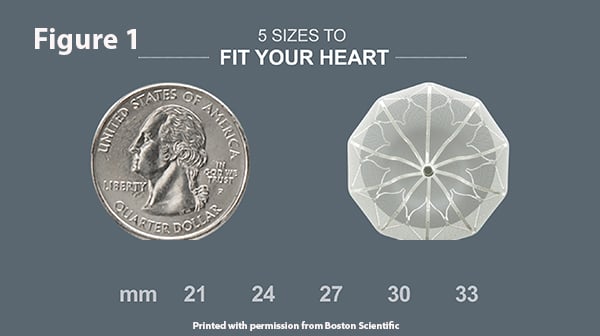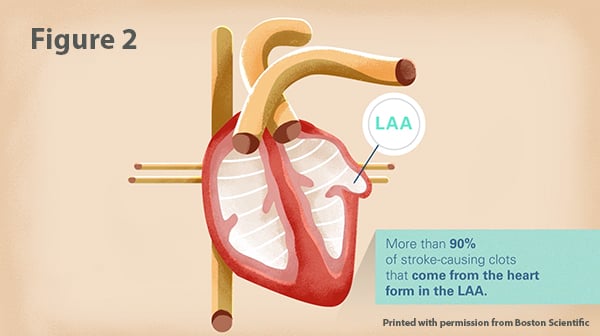Watchman Device for Atrial Fibrillation
MetroHealth's Heart & Vascular Center team consists of highly-trained surgeons who perform complex and lifesaving procedures.
Watchman Device for Preventing Stroke in Atrial Fibrillation
Atrial fibrillation (A-Fib) is the most common heart rhythm disorder in the United States affecting about 2.7 million people.
In A-Fib, the top chamber of the heart, called the atrium, is beating about 300-400 beats per minute which means that it really is no longer pumping blood and is just quivering. When this happens, slow blood flow in this chamber can cause a clot to form. This clot can break loose, travel to the brain and cause a stroke.
Patients with A-Fib are 5 times more likely to have a stroke than patients without A-Fib. Also, strokes in patients with atrial fibrillation are more likely to be severe or fatal.
Blood Thinners Can Prevent Stroke But Can Also Cause Bleeding
For decades, the treatment to prevent strokes was blood thinners. Blood thinners are very effective and reduce the risk of stroke in patients taking them by almost 70%. Warfarin, or coumadin, was the first blood thinner used in prevention of stroke. It is very effective, but it is difficult to take. It requires monthly blood tests and its effectiveness and bleeding risk can change with diet and other medications.
There are newer medications that are easier to take, are less altered by other medications and don’t require monthly blood tests. These medications are Rivaroxaban (Xarelto), Dabigatran (Pradaxa), Apixaban (Eliquis) and edoxaban (Savaysa).
While these blood thinners are very safe and effective, for many people they can cause bleeding. In some cases this bleeding is serious which prevents about one-third of people who need a blood thinner from taking one.
Fortunately, there are alternatives. One of these is the Watchman Device, an FDA-approved, small umbrella (Figure 1) that can be placed in the left atrial appendage (LAA) (Figure 2).


Printed with Permission from Boston Scientific.
The device is inserted into the heart from a tiny tube placed in the leg similar to a heart catheterization. The left atrial appendage is a small sac that is attached to the left atrium. When a patient is in A-Fib and the heart is quivering, the slowest blood flow is in the appendage and most clots form in this location.
The Watchman device can be inserted into the appendage preventing clots from going to the brain and causing a stroke. Patients who receive this device must be on a blood thinner for a short period of time but eventually this drug is stopped. There are rare risks of the procedure and not everyone can have this device.
Some important information about the WATCHMAN procedure:
- You will need a transesophageal echo (TEE) before the procedure.
- You will be on a blood thinner for a short period of time before the procedure.
- You will stay in the hospital overnight after the procedure.
- You will need to take aspirin and warfarin until you have your follow-up appointment.
- Your first follow-up appointment is 45 days after the procedure. Another TEE will be done at this appointment. If the TEE shows that the LAA is blocked, you will be able to stop taking warfarin and start taking clopidogrel (Plavix) for 6 months along with aspirin. After 6 months, you will stop taking clopidogrel, unless you need to take it for another reason. You will continue daily treatment with aspirin.
- If the TEE shows that the LAA is not blocked, you will continue taking warfarin and have another TEE and follow-up appointment after 6 months.
- Once the LAA is blocked, you will have a yearly follow-up appointment with your MetroHealth cardiologist. A repeat TEE will be done one year after the device was implanted.
Am I at Increased Risk of Stroke?
Not everyone is at risk of stroke with atrial fibrillation. You can find out your risk below. The American Heart Association and American College of Cardiology guidelines recommend blood thinners for men with a score of 2 or women with a score of 3.
| Question | Points |
| Are you a woman? | 1 point |
| What is your age? | 1 point if 65-74 years 2 points if older than 74 years |
| Do you have heart failure? | 1 point |
| Have you ever had high blood pressure? | 1 point |
| Have you ever had diabetes? | 1 point |
| Have you ever had a stroke or mini stroke? | 2 points |
| Do you have vascular disease (blocked blood vessels in the legs, neck arteries) or coronary artery disease (prior heart attack or stent)? | 1 point |
| Total Points |
| Total Points | Stroke Risk Each Year |
| 0 | 0% |
| 1 | 1.3% |
| 2 | 2.2% |
| 3 | 3.2% |
| 4 | 4.0% |
| 5 | 6.7% |
| 6 | 9.8% |
| 7 | 9.6% |
| 8 | 6.7% |
| 9 | 15.2% |
Source: Who will benefit from anticoagulant therapy? Use of the CHADS2 score and its variants
Request an Appointment
Call 216-778-2328 to request an appointment and see if the Watchman Device is right for you.